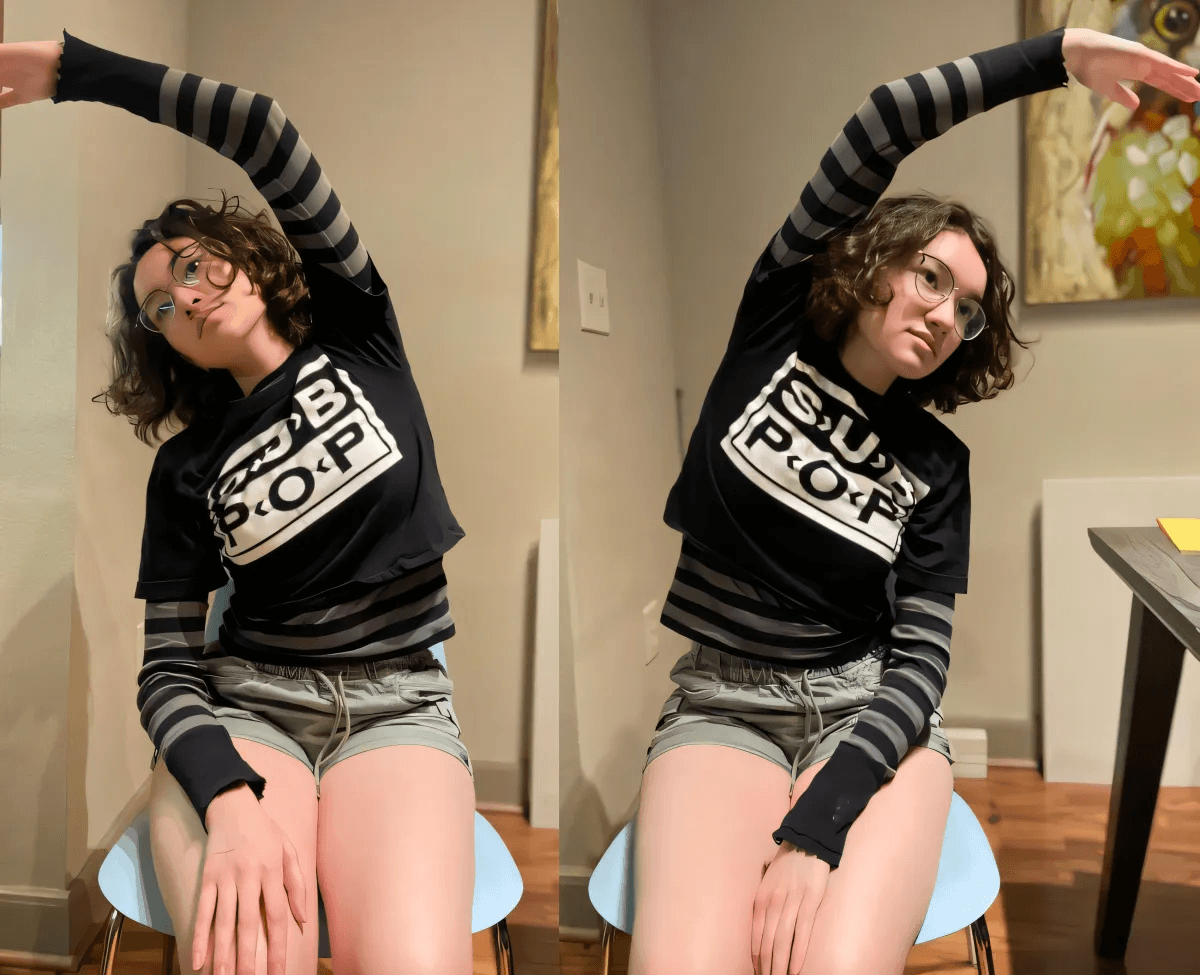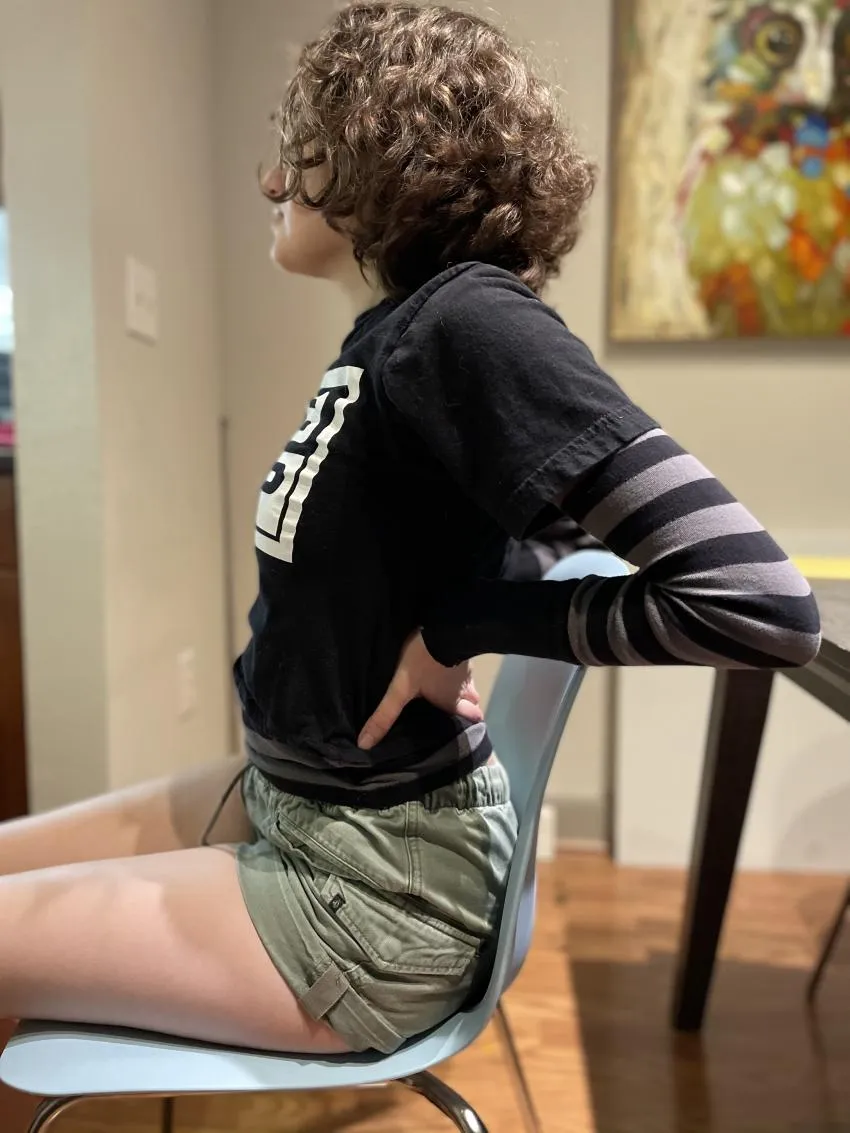15 Easy Desk Stretches For Computer Users
Some of the most common non-fatal work-related injuries are musculoskeletal injuries like sprains and strains that can occur in many types of workplaces, including office environments. Research shows that poor posture, repetitive motion, and staying in the same position for too long can cause or aggravate existing musculoskeletal injuries.
This is where "deskercise" comes in! Here are 15 easy stretches you can do at your desk to help prevent things like carpal tunnel syndrome, lower back pain, neck and shoulder pain, and other ailments associated with long term computer use:
1. Finger stretches
The repetitive motion of typing can mean our fingers end up stiff and painful. Do this quick routine to loosen them up:
- Separate your fingers until you feel a stretch. Hold that position for 10 seconds, then close your fingers into a fist and hold that for 10 more seconds. Repeat as many times as you'd like.
- Touch each of your fingers to your thumb, holding for three seconds. Repeat as many times as you'd like.
See the video below for a demonstration:
2. Thumb and wrist stretches
The repetitive motions of the wrists and fingers required by using a mouse and keyboard can lead to strain injuries and have been linked to carpal tunnel syndrome as well. Take a break and stretch out your thumbs and wrists every hour or so to avoid injuries that could continue to bother you for years.
- Make a fist around your thumb and bend your wrist down until you feel a stretch.
- Place your palm on a flat surface like a wall with your fingers pointing down. Then pull your thumb back until you feel a stretch in the palm side of your forearm.
- With your elbow straight, make a fist. Reach under and pull the fist downwards so you feel a stretch on the top of your forearm.
3. Shrug your shoulders
Oftentimes, after sitting at a computer for a while, our shoulders tend to roll forward and cause stiffness later in the day. Take a moment to sit with your back straight, shrug your shoulders up so they're touching your ears, hold, and then release.
4. Stretch your traps
All the time we spend staring at our various screens really takes a toll on our necks, which can be felt in our trapezius muscle, which spans the back of the neck and top of the shoulders. Stretch this muscle by tilting your head towards your left shoulder and applying gentle pressure to your head with your left hand. Repeat this stretch on the right side as well. View the first video in this Instagram post for a demonstration:
View this post on Instagram
5. Neck stretch
Another way to stretch your neck is by doing neck rotations. This is done by simply rotating your neck by looking over your shoulders. Repeating this stretch several times will improve the mobility in your neck.
6. Give yourself a "double chin"
Though it may look strange, this stretch can help prevent that "computer hunch" in our necks that comes from leaning into our monitors. Start by tucking your chin in slightly. Then, slide your head towards the back of your spine so that it is on top of your cervical spine. This will give you a "double chin" look. Do this 5 to 10 times.
7. Reach for the sky
Your shoulders and arms get stiff and sore from staying in one position all day as you type and use your mouse or trackpad. Stretch them our by lacing your fingers together, turning your palms upward as you stretch your arms above your head. Elongate your arms and you should feel the stretch through your arms and sides of your rib cage.

8. Triceps stretches
Your triceps, the muscle on the back up your upper arm, can get tight when you spend long periods of time with your arms at your sides as they adapt to this shorter position. To stretch them, lift up your arm and grab your elbow with your other hand. Pull your elbow towards your head and hold this stretch for about 20 seconds. Repeat for the other arm.
9. The "relaxing" stretch
This is another great stretch for your shoulders and it stretches your chest too. Lace your fingers and rest them behind your head. Keep your elbows straight out at your sides. Pull your shoulder blades towards each other until you feel a stretch throughout your upper back. Hold the stretch for ten seconds. Repeat as necessary.

10. Overhead latissimus stretch
Your latissimus dorsi muscles (or lats for short) are large muscles that span your back and sides. Just like your triceps, your lats can get tight from lack of stretching. Tight lats can contribute to poor posture, so it's important to keep them stretched. Do this by lifting your left arm and then reaching over to the right side. Hold this for about 20 seconds and then repeat with your right arm.

11. Calf raises
Stand up and get your blood flowing! Stand behind your chair and rest your hands on the back of your chair for support. Then, raise yourself up onto the balls of your feet while tightening your calf muscles. Slowly lower your heels back down to the ground.
12. Hamstring stretch
Keeping your legs bent in a sitting position all day can lead to short and tight hamstrings over time, which makes it hard for your legs to straighten out properly. Luckily, you can easily stretch these tendons at your desk. To start, extend one leg out in front of you. Then, straighten your back and lean forward, keeping your back straight until you feel the stretch in the back of your leg. Hold the stretch for about 20 seconds. Repeat this stretch on the other side.
13. Back extensions
Lower back problems can come from poor posture while sitting, like slouching forward or leaning too far back. This stretch can help alleviate some of that pain and be used as a reminder to reset yourself back to a good sitting position. You can do this lower back stretch either sitting or standing. With your feet firmly on the ground, place your palms on the small of your back. Then, lean back over your hands until you feel your lower back stretch out.

14. Seated hip and glute stretch
Your glutes and various hip muscles also suffer when you sit for extended periods of time. Start with your feet flat on the ground. Then, put your left ankle on top of your right knee. Sit up straight and then gently lean your torso forward until you feel a stretch in your left glute and hip. Pressing down on your left knee will deepen the stretch. Hold this for about 20 seconds and repeat for the other hip.
15.Trunk rotation
To get a good stretch for your whole back, start by sitting with your feet firmly on the ground. Rest one arm over the back of your chair and turn your upper body towards that arm. Hold this for 20 seconds and then repeat on the other side.

Incorporate these stretches into your daily workflow as breaks to keep your muscles happy and prevent long term repetitive stress and strain injuries!
Opinions and Perspectives
The wrist stretches are crucial for anyone who uses a computer mouse extensively.
These exercises plus regular walks have transformed my work experience.
Started doing these after developing tendonitis. They really help manage the pain.
These have become part of my daily routine. Can't imagine working without them now.
Nice to have exercises that don't require leaving my desk during busy periods.
The shoulder shrugs help me release tension I didn't even know I was carrying.
I appreciate how these can be modified based on individual flexibility levels.
I've noticed fewer headaches since I started doing the neck stretches regularly.
The thumb stretches really help after long sessions of scrolling on my phone.
I can't believe how much tension I hold in my shoulders until I do these stretches.
The hamstring stretch revealed how inflexible I've become. Working on it though!
Started doing these after my carpal tunnel diagnosis. Wish I'd known about them sooner.
The relaxing stretch is perfectly named. It's become my favorite way to release tension.
These are good preventive measures but don't ignore persistent pain. See a doctor if needed.
The back extensions help but I find standing desk breaks even more effective.
Never realized how important stretching was until I developed chronic neck pain.
I do these stretches plus take regular walks. The combination has been life-changing.
Wonder if anyone has suggestions for additional wrist exercises? That's my problem area.
The seated hip stretch revealed how tight my hips have become from sitting all day.
I appreciate that these don't require any special equipment or much space.
My doctor actually recommended several of these stretches during my last checkup.
Just tried the double chin exercise and can already feel it working my neck muscles.
I combine the neck stretches with deep breathing. Really helps reduce stress too.
The calf raises are great but I prefer to do them during bathroom breaks for privacy.
The trap stretch is my absolute favorite. I can feel the tension melting away instantly.
I found these helpful but still ended up needing to see a physical therapist for my shoulder pain.
Would love to see some additional stretches specifically for people who use multiple monitors.
The trunk rotation helps me crack my back in just the right spot. Such relief!
My whole team now does stretch breaks together. It's become a nice bonding activity.
The finger stretches seemed silly at first but they really help after hours of typing reports.
I've modified some of these to do while walking between meetings. Gets my blood flowing even more.
Yes! The stretches help me stay alert, especially during that afternoon slump.
Anyone else notice their energy levels improve when they do these throughout the day?
My neck pain has definitely improved since I started doing the trap stretches regularly.
I appreciate how most of these can be done discretely at my desk without drawing attention.
Start with a bent knee if you can't reach your toes. You'll gradually build flexibility.
While ergonomic solutions are important, these stretches have helped me manage existing pain and prevent it from getting worse.
Not convinced these will prevent serious injuries. We really need better ergonomic solutions at work.
I find the relaxing stretch particularly effective after long meetings where I've been sitting still.
My carpal tunnel symptoms have improved since I started doing the thumb and wrist stretches regularly.
I use a desktop app that reminds me to stretch every hour. Makes a huge difference in remembering to do these.
The latissimus stretch feels amazing but I always forget to do it. Need to set a reminder somehow.
Been doing these for a week now and my shoulders feel so much better. Really helps with my posture too.
The seated hip stretch is intense! I didn't realize how tight my hips were until I tried it.
I've noticed such a difference since incorporating these into my daily routine. My physiotherapist actually recommended many of these same stretches.
You can do the calf raises against a wall instead. Works just as well and it's much safer.
Not sure about the calf raises behind my chair. Seems a bit unsafe if the chair has wheels.
The back extensions have been a game changer for my lower back issues. I do them every couple of hours now.
These are great suggestions but I wish there were more exercises specifically for lower back pain.
Anyone else feel like the trunk rotation gives them an immediate sense of relief? It's become my go-to stretch.
Trust me, your coworkers probably wish they had the courage to do these too. I started doing them openly and now half my office joins in!
Seriously wondering how I'm supposed to do these stretches without looking weird in front of my coworkers.
The double chin exercise looks ridiculous but I'm willing to try anything to fix my tech neck.
I can confirm the finger stretches work wonders! I'm a programmer and they've helped me avoid hand cramping during long coding sessions.
The finger stretches seem too simple to be effective. Has anyone actually found them helpful?
I've been doing the shoulder shrugs for a while now and they really help reduce tension in my neck.
These stretches are exactly what I needed! My wrists have been killing me lately from all the typing I do.
